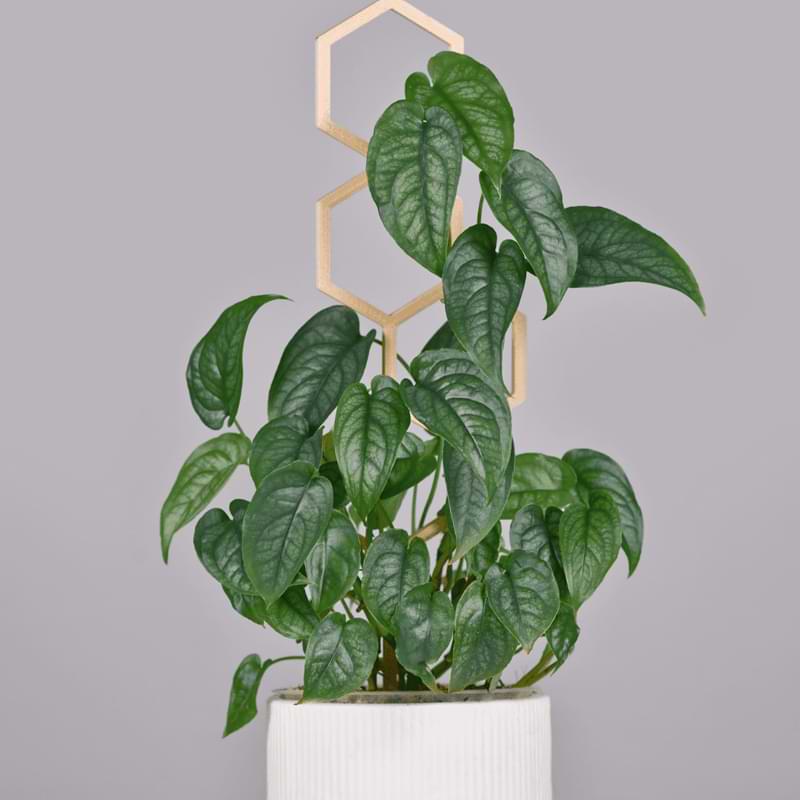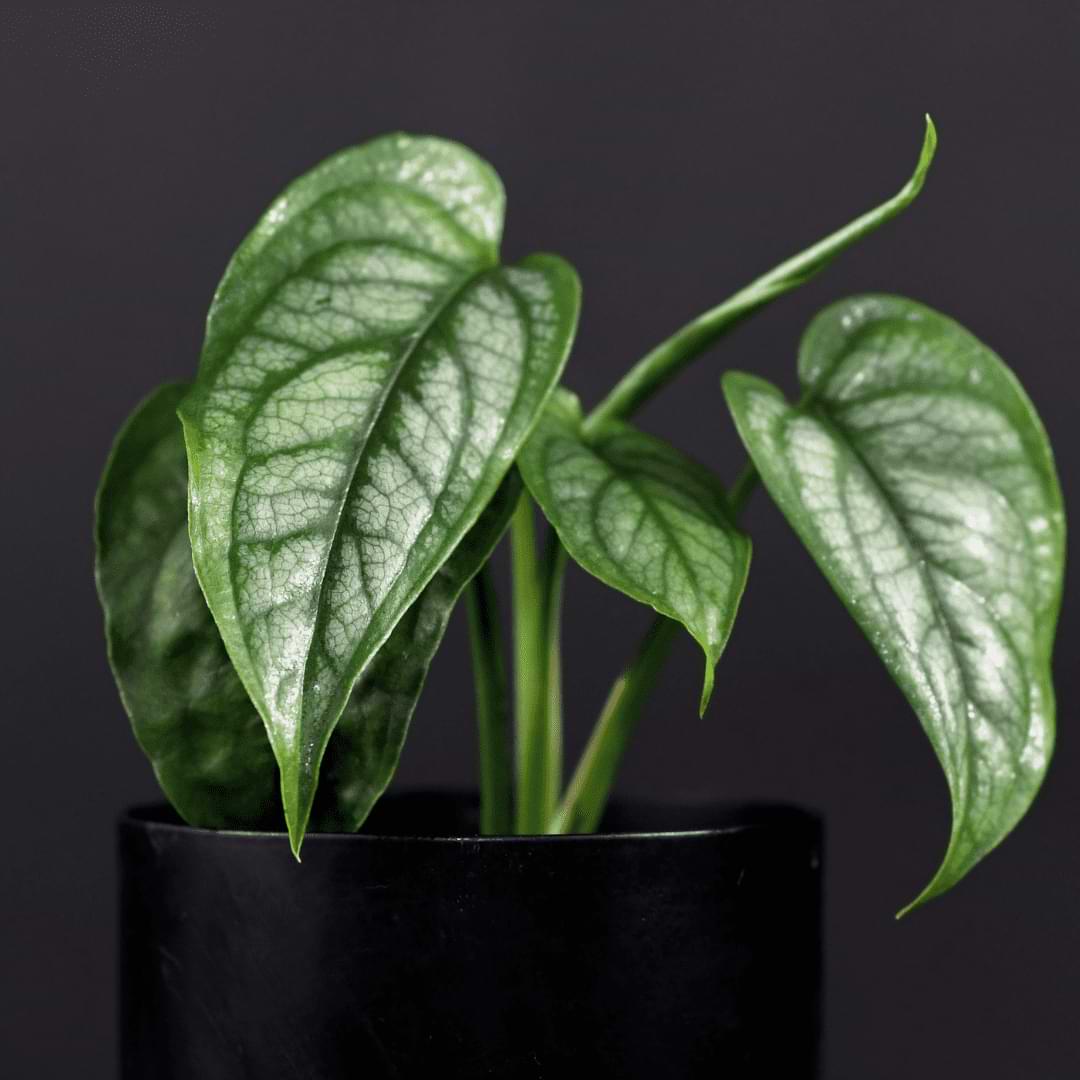The Monstera Siltepecana is a stunning monstera variety that many people have gravitated towards, and for good reason! It’s such a beautiful plant, and features some minor differences from typical monstera plants.
Table of Contents
Identifying Monstera Siltepecana
The Monstera Siltepecana undergoes a remarkable transformation from its juvenile stage to maturity. In its early days, the leaves of this tropical beauty display a unique pattern of silver and dark green hues. As it grows older, the foliage develops deep splits and holes, resembling the iconic “swiss cheese” appearance that Monstera plants are famous for. These holes, more accurately called fenestrations, can range from small slits to larger openings that will let light through to the lower leaves.
One notable difference between Monstera Siltepecana and its close relative, the El Salvador variety is their leaf shape. While both species exhibit large heart-shaped leaves with distinctive fenestrations or splits, Siltepecana’s foliage tends to be narrower and elongated compared to the broader leaves of El Salvador.
Monstera Siltepecana has a climbing habit with aerial roots that allow it to attach itself onto trees or other supports in its natural habitat. However, when cultivated indoors as a houseplant, it adapts well to hanging baskets or trellises where it can gracefully trail down.
Monstera Siltepecana Care Guide
The Siltepecana requires care similar to that of most other monstera varieties, and luckily does not have any species-specific requirements. The Siltepecana is the perfect houseplant to add to your indoor garden because of the relatively simple care it needs. Still, there are certain aspects of caring for any monstera plant that will help this plant thrive in your home.
Soil
Soil plays a crucial role in the overall health and growth of your Monstera Siltepecana. Choosing the right soil mixture is essential to ensure that your plant thrives in its environment. The Siltepecana, along with other monstera varieties, requires well-draining soil with plenty of organic matter to break down and feed your plant over time. Aim to plant your monstera in a soil blend that is specifically formulated for monstera varieties.
Light
Monstera Siltepecana thrives in bright, indirect light, similar to most other monstera varieties. It can also tolerate lower light conditions, but not for too long. In its native environment in Central America, Monstera Siltepecana grows under the shade of larger trees. Therefore, it prefers filtered or dappled sunlight rather than direct sun exposure. If you have your monstera by a window that gets direct light, especially afternoon sun, you’ll want to find a way to partially shade the plant, mimicking the natural shade it would get under the tree canopy in its natural environment.
Water
Monstera Siltepecana prefers slightly moist soil. Be very careful of overwatering this plant, as this can lead to root rot which could potentially kill your beautiful monstera. The frequency of watering will depend on various factors such as temperature, humidity, and the size of your plant.
To water your Monstera Siltepecana effectively, check the top inch or so of soil before each watering by sticking your finger into the soil. If it feels dry to touch, it’s time to water. Make sure that you saturate the soil thoroughly until water drains out from the bottom of the pot, and then allow all extra water to drain out. During winter or cooler months when growth slows down, reduce watering frequency accordingly. Alternatively, during warmer or dryer months, you may need to water more frequently.
Temperature
This tropical plant thrives in warm temperatures, ideally ranging between 65°F and 85°F. However, it can tolerate temperatures slightly outside of this range, but it will not thrive if left outside of the ideal temperature range for too long.
Avoid exposing this plant to drastic fluctuations or extreme cold drafts, as this can cause stress and damage its leaves. Some ways this could happen is if the plant is near a window that is frequently opened in the winter, or if it’s placed near a heating/cooling vent. Plenty of air flow is a requirement to keep your plant healthy, just try not to let that air flow drastically change the temperature around your plant.
Humidity
As a tropical plant, the Siltepecana thrives in high humidity environments. In fact, maintaining adequate humidity levels is essential for its overall health and growth. Using a humidity meter will let you know if the humidity levels around your plant are ideal for its growth and overall health.
To create a humid environment for your Monstera Siltepecana, you can use several methods. One option is to place a humidity tray filled with water near the plant. You can also just use a simple humidifier near the plant. Many people choose to mist the leaves regularly with water using a spray bottle, but standing water on leaves could lead to fungal development, so it’s not recommended unless there is no other way to increase the humidity.
Fertilization
Using a proper fertilizer for your monstera will not only make it grow well and look beautiful, it will also keep the plant healthy and able to fight off diseases. Not all fertilizers are created equal, so make sure to find one that is specifically made for tropical indoor plants. Even better, using a plant food that is formulated specifically for monstera varieties will ensure your plant gets everything it needs while minimizing the risk of fertilizer burn.
Repotting
Repotting your Monstera Siltepecana is an important step in ensuring its continued growth and health. As this plant matures, it will outgrow its original pot and require a larger space to thrive.
First, try to only repot your plant during the spring or early summer months when the plant is actively growing. This allows it to recover more quickly from any stress caused by the repotting process.
Second, when selecting a new pot for your Monstera Siltepecana, opt for one that is slightly larger than its current container. 1-2 inches larger is the general recommendation, although it is okay to go up to 4 inches larger than the current pot. Up-potting this way provides ample room for root expansion without overwhelming the plant with too much space.
To repot your plant, simply put about an inch or two of new potting soil at the bottom of the new pot, remove your plant from its current pot, and place it in the new one, backfilling the empty space with new potting soil.
This is the perfect opportunity to inspect the roots and the soil health, so it’s a good idea to do so before placing your plant in its new container. First, loosen the soil around the root ball so you can look through the entire root system. Inspect for off-colored or mushy roots, and if you do find any, use sterilized pruning shears to cut them off. Try to get all of the diseased roots off if they are present on your plant. After doing this, you can re-pot like normal, being careful not to crush the roots all together–you want soil around and inside of the root system to give the plant airflow and stability.
Pruning
Pruning is an important aspect of Monstera Siltepecana care, helping to maintain the health and shape of the plant. Regular pruning can also encourage new growth and prevent overcrowding. When pruning your monstera, there are a few key things to keep in mind.
First, make sure you have clean and sharp pruning shears or scissors before you begin. This will help ensure a clean cut and minimize the risk of introducing any diseases or pests to your plant. Next, look for any dead or yellowing leaves as well as any stems that are leggy or overgrown. Trim these back to promote healthy growth and improve the overall appearance of your plant. Any pruning outside of this can be done either for aesthetic purposes or to create new plants through propagation. Either way, try not to remove too much of your plant, as it could send your monstera into shock.

Propagating Monstera Siltepecana
Propagating Monstera Siltepecana is an exciting and rewarding process that allows you to expand your collection or share the beauty of this stunning plant with friends. There are a few different methods you can use to propagate your plant, so try one or all, and enjoy your new plants!
The most common way to propagate your monstera is by water. To do this, you’ll need to take a cutting from your plant that includes at least one growth node–a bump on the side of the stem, typically opposite from where a leaf stem emerges from. After you have your cutting, remove any lower leaves, ensuring you have at least one leaf left at the top of the cutting, and place the cutting in a jar filled with clean water. Change the water every 2-3 days, and within a few weeks you should begin to see root growth from the cut end of the stem! After the roots are 2-3 inches long, you can pot the cutting up in some soil and enjoy your new plant.
Another popular way to propagate a monstera is soil propagation, which follows the same steps as water propagation, except instead of rooting in water, the plant is allowed to root directly in the soil. Rooting hormone can help to speed up the rooting process, making stem rot less likely to occur before your cutting has a chance to produce new roots. With this process, you’ll need to keep the soil moist until you notice new growth above the soil. After that, you can move to the regular maintenance watering you would have with a mature monstera plant.
Common Problems
Like any houseplant, Monstera Siltepecana can encounter a few common problems. Understanding and resolving these issues will help keep your plant healthy and thriving.
Root Rot
Root rot is a fungal disease that occurs when the roots are constantly exposed to excessive moisture, leading to decay and damage. It’s important to catch root rot early on since it can quickly spread throughout the plant and cause irreversible damage.
The main cause of root rot is overwatering. While Monstera Siltepecana enjoys moist soil, it’s crucial not to let the roots sit in water for extended periods. Ensure proper drainage by using well-draining soil and allowing excess water to escape through drainage holes.
Brown or yellow leaves
Brown or yellow leaves on your Monstera Siltepecana can be a sign of stress or an underlying issue. It’s important to pay attention to these changes in leaf color as they can indicate problems with the plant’s health.
There are several things that can cause discolored leaves, like overwatering, underwatering, pest infestations, and a lack of nutrients. You’ll need to do some detective work to figure out what is causing the brown or yellow leaves on your monstera, and treat the problem accordingly.
Drooping Leaves
One of the most common reasons for droopy leaves is overwatering. When the soil is consistently saturated, the roots can become waterlogged and suffocate. One of the first signs of this problems is wilting and drooping foliage. Confusingly, underwatering can also cause drooping leaves. Some other causes of drooping leaves include improper lighting or humidity levels, nutrient deficiencies, and even too many nutrients, such as too much fertilizer.
Pests
Pests can be a nuisance when it comes to caring for your Monstera Siltepecana. These pesky critters can wreak havoc on the health and appearance of your plant if left unchecked. Here are a list of pests to watch for:
- Spider mites
- Mealybugs
- Fungus gnats
- Aphids
- Scale insects
To prevent these pests from infesting your plant, it’s important to regularly inspect both sides of each leaf for any signs of trouble. If you do notice an infestation, get rid of them as quickly as possible with natural remedies like neem oil spray or water and dish soap wiped on each leaf, top and bottom. Remember, staying vigilant against pests will help ensure that your Monstera Siltepecana remains healthy and vibrant!
Monstera Siltepecana
What is the life expectancy of Monstera?
The life expectancy of a Monstera Siltepecana is highly dependent on various factors such as environmental conditions, care practices, and genetics. Generally speaking, with the right conditions, a well-cared-for Monstera Siltepecana can thrive for decades.
Is monstera Siltepecana toxic to pets?
Unfortunately, Monstera Siltepecana is toxic to both cats and dogs. The plant contains calcium oxalate crystals that can cause irritation and discomfort if ingested by pets. Symptoms may include drooling, vomiting, difficulty swallowing, oral pain, and swelling.





